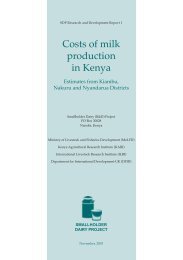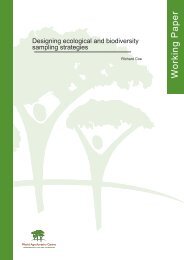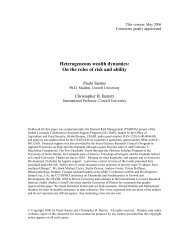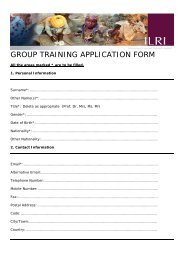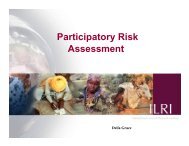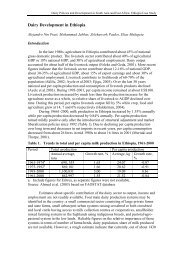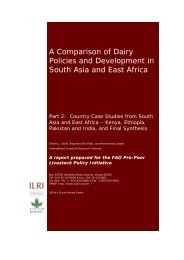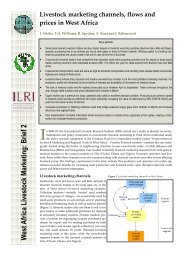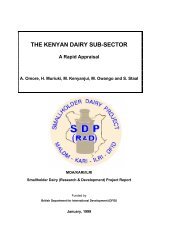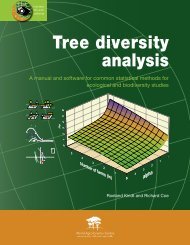Improvement of Livestock Production in Crop-Animal Systems in ...
Improvement of Livestock Production in Crop-Animal Systems in ...
Improvement of Livestock Production in Crop-Animal Systems in ...
Create successful ePaper yourself
Turn your PDF publications into a flip-book with our unique Google optimized e-Paper software.
Table 2.Importance <strong>of</strong> ra<strong>in</strong>fed agriculture <strong>in</strong> South-East Asia.CountryTotal ra<strong>in</strong>fedarea (10 6 ha)Arable land as aproportion <strong>of</strong> totalra<strong>in</strong>fed area (%)Ra<strong>in</strong>fed productionas proportion <strong>of</strong>agricultural GDP (%)Populationdependent on ra<strong>in</strong>fedagriculture (%)Average farmsize (ha)ASEANIndonesia 9.1 62.7 19.1 36.8 0.8Malaysia 0.7 67.5 16.0 40.2 1.4Philipp<strong>in</strong>es 6.5 82.3 22.3 36.0 1.9Thailand 13.8 81.6 49.9 59.4 4.3MekongCambodia 2.8 96.9 NA NA 2.5Lao PDR 0.8 94.6 NA 85.0 1.3Myanmar 8.9 89.8 61.1 46.0 2.3Vietnam 4.4 71.6 NA 75.0 2.0Ch<strong>in</strong>a † 52.0 53.8 33.0 30.0 0.5–1.0Sources: ADB (1996) and data from the <strong>in</strong>dividual countries.NA: not available.† Data refer to the whole country, as separate data are not available for South Ch<strong>in</strong>a.SoilsAccord<strong>in</strong>g to Dent (1980), 86% <strong>of</strong> soils <strong>in</strong> South-East Asia have serious limitations <strong>of</strong> m<strong>in</strong>eral stress (59%),water excess (19%), shallow depth (6%) and drought (2%). Most soils are ultisols and oxisols. Descriptions<strong>of</strong> these soils are given by Dent (1980) and Dudal (1980). These soils occupy 50% <strong>of</strong> the land area <strong>of</strong> tropicalAsia, and cover 188 million ha <strong>of</strong> uplands <strong>in</strong> South-East Asia (Garrity and Agust<strong>in</strong> 1995). Ultisols are moreimportant than oxisols <strong>in</strong> the region; the latter be<strong>in</strong>g more widespread <strong>in</strong> South America and sub-SaharanAfrica. For example, <strong>in</strong> Indonesia, there are 49 million ha (25.7% <strong>of</strong> the total land area) <strong>of</strong> ultisols and 18million ha <strong>of</strong> oxisols, with major areas occurr<strong>in</strong>g on the islands <strong>of</strong> Sumatera and Kalimantan. In thePhilipp<strong>in</strong>es, ultisols and oxisols cover 17 million ha (58% <strong>of</strong> the land area) whilst <strong>in</strong> Thailand, ultisols occupy44.8% <strong>of</strong> the land area and oxisols less than one per cent. In Malaysia and Myanmar, 52.8 and 59.5% <strong>of</strong>arable land, respectively, are ultisols and oxisols. These soils present severe physical constra<strong>in</strong>ts forpermanent cultivation, with low <strong>in</strong>herent fertility (especially phosphorus), high acidity (pH 3.5–5.0), toxiclevels <strong>of</strong> alum<strong>in</strong>ium, low organic matter content, high erodability and poor water economy.Ra<strong>in</strong>fed farm<strong>in</strong>g systems <strong>in</strong> the agro-ecological zonesGeneralBackground <strong>in</strong>formation for Asia on the target AEZs is shown <strong>in</strong> Table 3. Currently, data for the AEZs <strong>in</strong>South-East Asia are not available, so the statistics presented <strong>in</strong>clude south Asia. However, most <strong>of</strong> the humidand sub-humid lowlands are found <strong>in</strong> South-East Asia as the lowlands <strong>of</strong> south Asia are semi-arid or arid. Thelowlands have larger areas <strong>of</strong> arable and permanent cropland, which account for the greater crop production <strong>in</strong>this AEZ. The data also <strong>in</strong>dicate that about 51% <strong>of</strong> the cattle and 55% <strong>of</strong> the small rum<strong>in</strong>ant populations <strong>in</strong> Asiaare found <strong>in</strong> these AEZs. Unfortunately, no data were available for the sizes <strong>of</strong> buffalo and non-rum<strong>in</strong>ant (pigsand poultry) populations, but relatively large numbers <strong>of</strong> more than 75% <strong>of</strong> buffaloes and about 70% <strong>of</strong>non-rum<strong>in</strong>ants are found on small farms. The buffaloes are ma<strong>in</strong>ly the swamp type <strong>in</strong> South-East Asia, and areassociated with about 33% <strong>of</strong> the total population <strong>of</strong> buffaloes <strong>in</strong> Asia (Chantalakhana 1994).Mixed farm<strong>in</strong>g systems that <strong>in</strong>clude crops and animals are found <strong>in</strong> the AEZs. Annual crops (rice, wheat,maize, pulses and oilseeds) and perennial tree crops (coconut, oil palm, rubber and fruits) are grown, andboth rum<strong>in</strong>ants (buffaloes, cattle, goats and sheep) and non-rum<strong>in</strong>ants (pigs and poultry) are <strong>in</strong>tegrated <strong>in</strong>tothese systems. Pig and poultry breeds are ma<strong>in</strong>ly <strong>of</strong> the <strong>in</strong>digenous types. Ducks predom<strong>in</strong>ate <strong>in</strong> the ra<strong>in</strong>fed



